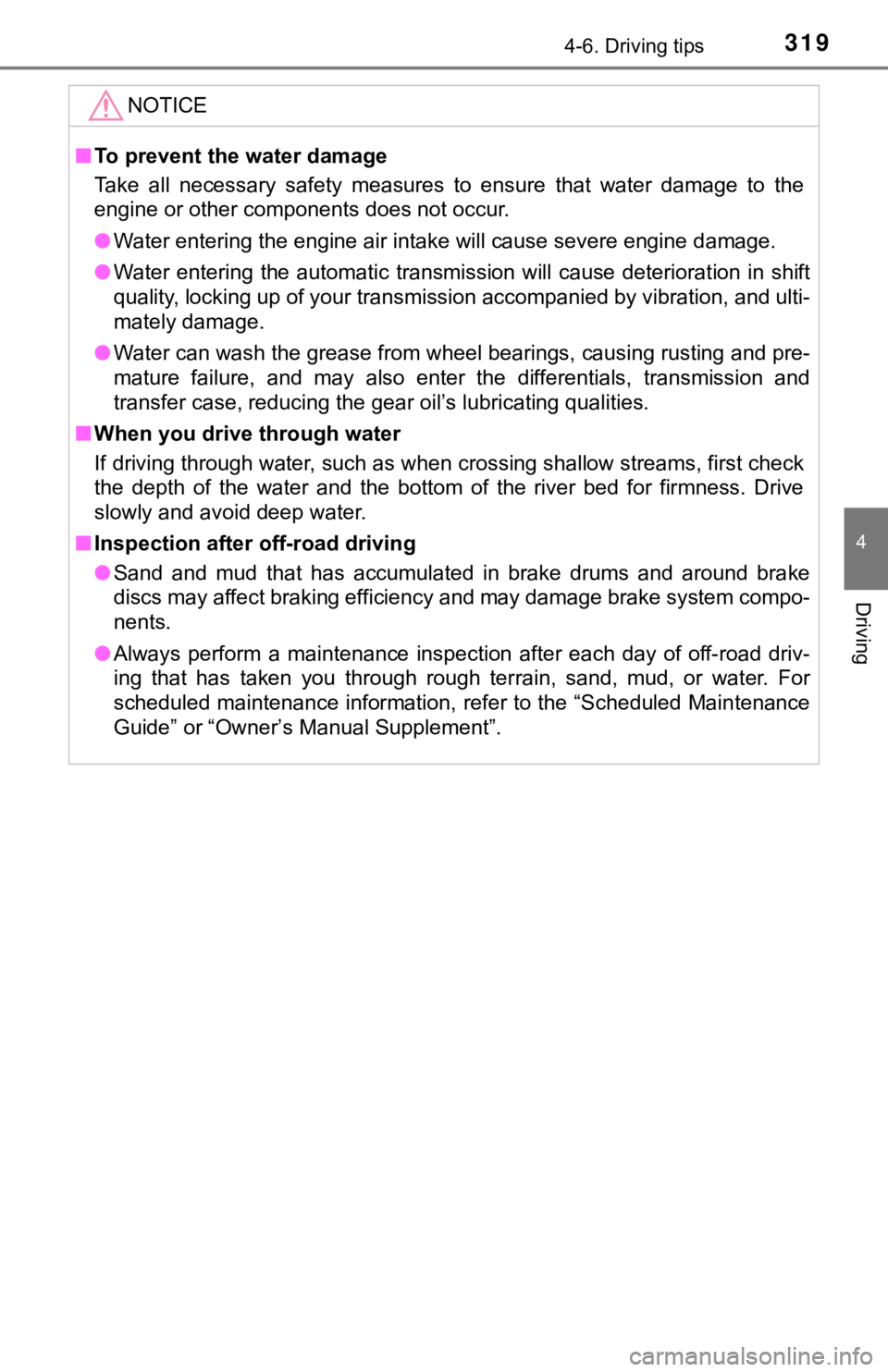Page 191 of 672

1914-1. Before driving
4
Driving
■Break-in schedule
If your vehicle is new or equipped with any new power train com ponents
(such as an engine, transmission, differential or wheel bearing ), Toyota rec-
ommends that you do not tow a trailer until the vehicle has bee n driven for
over 500 miles (800 km).
After the vehicle has been driven for over 500 miles (800 km), you can start
towing. However, for the next 500 miles (800 km), drive the veh icle at a speed
of less than 50 mph (80 km/h) when towing a trailer, and avoid full throttle
acceleration.
■ Maintenance
●If you tow a trailer, your vehicle will require more frequent m aintenance due
to the additional load. (See “Owner’s Warranty Information Book let” or
“Scheduled Maintenance Guide”/“Owner’s Manual Supplement”.)
● Retighten the fixing bolts of the towing ball and bracket after approximately
600 miles (1000 km) of trailer towing.
■ If trailer sway occurs
One or more factors (crosswinds, passing vehicles, rough roads, etc.) can
adversely affect handling of your vehicle and trailer, causing instability.
● If trailer swaying occurs:
• Firmly grip the steering wheel. Steer straight ahead.
Do not try to control trailer swaying by turning the steering wheel.
• Begin releasing the accelerator pedal immediately but very gra dually to
reduce speed.
Do not increase speed. Do not apply vehicle brakes.
If you make no extreme correction with the steering or brakes, your vehicle
and trailer should stabilize. (if enabled, Trailer Sway Control can also help to
stabilize the vehicle and trailer.)
● After the trailer swaying has stopped:
• Stop in a safe place. Get all occupants out of the vehicle.
• Check the tires of the vehicle and the trailer.
• Check the load in the trailer.
Make sure the load has not shifted.
Make sure the tongue weight is appropriate, if possible.
• Check the load in the vehicle. Make sure the vehicle is not overloaded after occupants get in.
If you cannot find any problems, the speed at which trailer swaying occurred
is beyond the limit of your particular vehicle-trailer combinat ion.
Drive at a lower speed to prevent instability. Remember that sw aying of the
towing vehicle-trailer increases as speed increases.
Page 319 of 672

3194-6. Driving tips
4
Driving
NOTICE
■To prevent the water damage
Take all necessary safety measures to ensure that water damage to the
engine or other components does not occur.
● Water entering the engine air intake will cause severe engine d amage.
● Water entering the automatic transmission will cause deteriorat ion in shift
quality, locking up of your transmission accompanied by vibrati on, and ulti-
mately damage.
● Water can wash the grease from wheel bearings, causing rusting and pre-
mature failure, and may also enter the differentials, transmission and
transfer case, reducing the gear oil’s lubricating qualities.
■ When you drive through water
If driving through water, such as when crossing shallow streams , first check
the depth of the water and the bottom of the river bed for firm ness. Drive
slowly and avoid deep water.
■ Inspection after off-road driving
● Sand and mud that has accumulated in brake drums and around bra ke
discs may affect braking efficiency and may damage brake system compo-
nents.
● Always perform a maintenance inspection after each day of off-r oad driv-
ing that has taken you through rough terrain, sand, mud, or wat er. For
scheduled maintenance information, refer to the “Scheduled Main tenance
Guide” or “Owner’s Manual Supplement”.
Page 556 of 672
![TOYOTA TUNDRA 2018 Owners Manual (in English) 5568-2. Steps to take in an emergency
(If equipped)
Indicates that the vehicle has deviated from the
lane (while the LDA [Lane Departure Alert] sys-
tem is operating).• The lane line TOYOTA TUNDRA 2018 Owners Manual (in English) 5568-2. Steps to take in an emergency
(If equipped)
Indicates that the vehicle has deviated from the
lane (while the LDA [Lane Departure Alert] sys-
tem is operating).• The lane line](/manual-img/14/43029/w960_43029-555.png)
5568-2. Steps to take in an emergency
(If equipped)
Indicates that the vehicle has deviated from the
lane (while the LDA [Lane Departure Alert] sys-
tem is operating).• The lane line on the side the vehicle hasdeviated from flashes in Yellow.
• A buzzer also sounds.
Check around the vehicle and back to
inside of the lane lines.
(Flashes)
Indicates that the engine was stopped with the
shift lever not in P.
A buzzer also sounds.
Shift the shift lever to P.
(Flashes)
Indicates that the engine was stopped while driv-
ing.
A buzzer also sounds.
Stop the vehicle in a safe place such as the
shoulder of a road.
Indicates that the engine coolant temperature is
too high
A buzzer also sounds.
Immediately stop the vehicle in a safe place
and contact your Toyota dealer.
Indicates a malfunction in the automatic transmis-
sion system
A buzzer also sounds.
Have the vehicle inspected by your Toyota
dealer immediately.
Warning messageDetails/Actions
(Yellow/
flashes)
Engine Stopped
Shift Into P
Engine Stopped
Stop In a Safe Place
Engine Coolant
Temp High
Stop in a Safe Place
See Owner’s Manual
CHECK
TRANSMISSION
SYSTEM
Page 557 of 672

5578-2. Steps to take in an emergency
8
When trouble arises
(If equipped)
Indicates a malfunction in the intuitive parking
assistThe malfunctioning assist-sensor is flashing.
Have the vehicle inspected by your Toyota
dealer immediately.
(If equipped)
Indicates a malfunction in the Blind Spot Monitor
A buzzer also sounds.
Have the vehicle inspected by your Toyota
dealer immediately.
Indicates that one or more of the doors or the
hood is not fully closed
The system also indicates which doors are not
fully closed.
If the vehicle reaches a speed of 3 mph
(5 km/h), flashes and a buzzer
sounds to indicate that the door(s) are not
yet fully closed.
Make sure that all the doors and the hood
are closed.
Indicates that the automatic transmission fluid
temperature is to high
A buzzer also sounds.
Immediately stop the vehicle in a safe
place, shift the shift lever to P and wait until
the light goes off.
If the light goes off, you may start the vehi-
cle again. If the light does not go off, con-
tact your Toyota dealer.
Indicates that the parking brake is still engaged
If the vehicle reaches a speed of 3 mph
(5 km/h), flashes and a buzzer
sounds to indicate that the parking brake is
still engaged.
Release the parking brake.
Warning messageDetails/Actions
Parking Assist
Malfunction
Blind Spot Monitor Malfunction
Visit Your Dealer
High Transmission Fluid Temp
See Owner’s Manual
Release
Parking Brake
(U.S.A) (Canada)